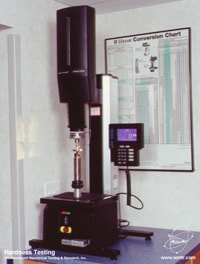The Rockwell Scale

It is typically used in engineering and metallurgy and is most common in the USA. Its commercial popularity arises from its speed, reliability, robustness, resolution and small area of indentation.
There are several alternative scales, the most commonly used being the "B", and "C" scales. Both express hardness as an arbitrary dimensionless number.
The B-scale is used for softer materials (such as aluminum, brass, and softer steels). It employs a hardened steel ball as the indenter and a 100kg weight to obtain a value expressed as "HRB".
The C-scale, for harder materials, uses a diamond cone, known as a Brale indenter and a 150kg weight to obtain a value expressed as "HRC".
The depth of penetration is converted to a scale in which a harder material gives a higher number.
Common values
- Very hard steel (e.g. a good knife blade) HRC 55 to HRC 62 or so
- Axes, chisels, etc. HRC 40 - 45
Readings below HRC 20 are generally considered unreliable, as are readings much above HRB 100.
Several other scales, including the extensive A-scale, are used for specialized applications. There are special scales for measuring case-hardened specimens.
Good practice includes:
- Cleaning indenter and test-piece to be clear of dirt, grease, rust or paint;
- Measuring on a perpendicular, flat surface ("round work correction factors" are invoked to adjust for test-piece curvature);
- Ensuring that the thickness of the test-piece is at least 10 times the depth of the indentation;
- Maintaining an adequate spacing between multiple indentations; and
- Controlling the speed of the indentation.
Standards
International (ISO)
- ISO 6508-1 : Metallic materials -- Rockwell hardness test -- Part 1: Test method (scales A, B, C, D, E, F, G, H, K, N, T)
US standard (ASTM International)
- ASTM E18 : Standard methods for rockwell hardness and rockwell superficial hardness of metallic materials



